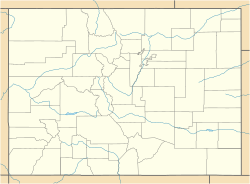Mantle's Cave facts for kids
Quick facts for kids |
|
|
Mantle's Cave
|
|
| Nearest city | Dinosaur, Colorado |
|---|---|
| Area | less than one acre |
| NRHP reference No. | 94000394 |
| Added to NRHP | May 10, 1994 |
Mantle's Cave is a large rock shelter found in Dinosaur National Monument in Moffat County, Colorado. It is located in a special part of the park called Castle Park. This cave is the biggest rock shelter in that area. It was discovered before 1921 by local ranchers, Mr. and Mrs. Charles Mantle.
Contents
Discovering Mantle's Cave
Mrs. Mantle was one of the first people to dig around the site. Later, in 1933, a group from Colorado College and the Fountain Valley School explored the cave. They called it "Cave One."
Mantle's Cave is very important for learning about the Fremont culture. These were ancient people who lived in this region. The cave is one of the best places to find information about them in northwestern Colorado. Digs in the 1930s and 1940s helped us learn a lot about the Fremont people. They also showed how the Fremont might be connected to the later Ancestral Puebloans.
What Was Found Inside?
When people explored Mantle's Cave, they found places where people might have lived. They also found storage areas, like small granaries for food. Many items were recovered, including pieces of pottery, baskets, and tools for hunting.
A big excavation was done by the University of Colorado Museum in 1939 and 1940. It was led by Charles R. Scoggin and Edison P. Lohr. The most important discoveries were found in small holes. These holes were probably used to hide things for a short time. Inside, they found stone and bone tools, animal bones, beads, seeds, and pieces of clothing and shoes. The most exciting find was a bag with a feathered headdress and other special items.
Work at the cave stopped because of World War II. Sadly, Charles Scoggin passed away during the war in 1944. Limited work started again in 1947 and 1948, led by Robert Burgh. Not many new things were found then. No human remains were ever discovered by any of the teams.
Why Was the Cave Used?
The people who studied the cave believed it was mostly used for storage. They found little evidence that people lived there for a long time. This might be because the cave faces north and is quite high up (about 1,635 meters or 5,365 feet). This would have made it a cold and uncomfortable place to live.
Most of the items found belong to the Fremont culture. Researchers also found charcoal deep down, suggesting the cave was used even earlier. However, this deeper layer has not been fully explored yet. In total, 53 different features, like storage pits or built areas, have been found in the cave. There are also some ancient rock carvings (petroglyphs) and some more recent graffiti in the alcove. The findings from the expeditions were published in 1948 in a book called The Archeology of Castle Park, Dinosaur National Monument.
The Cave's Features
Mantle's Cave faces north. It is wider than it is deep. It is about 100 meters (328 feet) wide and about 40 meters (131 feet) deep. The total area inside is about 3,140 square meters (33,799 square feet).
The cave is located about 450 meters (1,476 feet) south of the Yampa River. It sits about 100 meters (328 feet) higher than the river. The alcove is carved into Weber sandstone rock. It is just below the edge of a bench in the valley walls.
All the artifacts collected from Mantle's Cave are kept safe at the University of Colorado Museum of Natural History. Mantle's Cave was added to the National Register of Historic Places on May 10, 1994. This means it is recognized as an important historical site.



